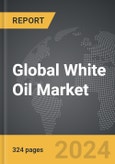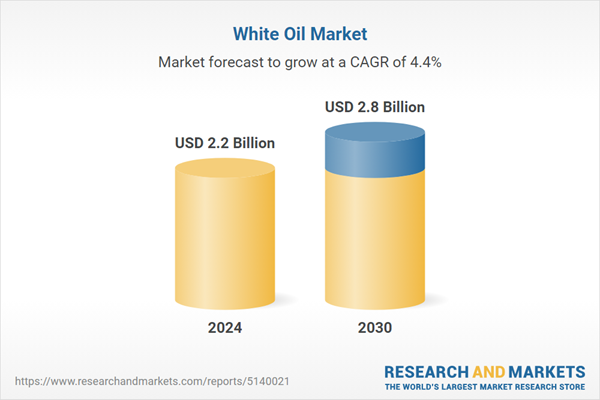The global market for White Oil was estimated at US$2.2 Billion in 2024 and is projected to reach US$2.8 Billion by 2030, growing at a CAGR of 4.4% from 2024 to 2030. This comprehensive report provides an in-depth analysis of market trends, drivers, and forecasts, helping you make informed business decisions. The report includes the most recent global tariff developments and how they impact the White Oil market.
Global White Oil Market - Key Trends & Drivers Summarized
Why Is White Oil Gaining Traction Across Various Industries?
White oil, a highly refined mineral oil that is colorless, odorless, and chemically stable, is becoming increasingly valuable across multiple industries due to its versatility and purity. It is extensively used in applications such as cosmetics, pharmaceuticals, food processing, and plastics due to its non-toxic and non-reactive nature. In the cosmetics and personal care sector, white oil serves as a base ingredient in creams, lotions, and baby oils, providing moisture retention and smooth texture. In pharmaceuticals, it is used in ointments, laxatives, and lubricants, while in the food industry, it acts as a release agent and a protective coating. The demand for high-purity white oils is rising as companies seek safe, stable, and versatile ingredients that meet stringent regulatory standards and consumer safety expectations.How Are Technological Advancements Enhancing the Quality of White Oil?
Technological advancements in refining processes are significantly enhancing the quality, purity, and performance of white oil. Innovations such as high-pressure hydrogenation and hydrocracking are removing impurities, aromatic compounds, and sulfur, resulting in highly refined white oils that meet the demanding quality standards required by industries such as pharmaceuticals, cosmetics, and food processing. The development of food-grade and pharmaceutical-grade white oils that comply with stringent regulatory requirements, such as the United States Pharmacopeia (USP) and the European Pharmacopoeia (EP), is gaining traction among manufacturers and consumers who prioritize safety and quality. Additionally, advancements in packaging and distribution are ensuring the stability and longevity of white oil products, minimizing contamination risks and enhancing shelf life.What Are the Challenges and Opportunities in the White Oil Market?
The white oil market faces several challenges, including fluctuating raw material prices, regulatory compliance, and competition from alternative ingredients and synthetic oils. Additionally, the increasing focus on sustainability and environmental impact is prompting companies to seek eco-friendly and biodegradable alternatives to traditional white oil. However, these challenges also present opportunities for growth and innovation. The development of biodegradable and renewable white oils derived from plant-based sources can help companies align with sustainability goals and meet consumer demand for greener products. The growing demand for high-purity white oils in emerging markets, driven by expanding pharmaceutical, cosmetics, and food processing industries, is creating new growth opportunities. Moreover, the rise of e-commerce and direct-to-consumer sales channels is driving the need for innovative marketing strategies and consumer engagement, providing brands with new avenues to reach potential customers.What Is Driving the Growth of the White Oil Market?
The growth in the White Oil market is driven by several factors, including the rising demand for high-purity, safe, and stable ingredients in cosmetics, pharmaceuticals, and food processing, as well as technological advancements in refining processes. The increasing focus on product safety and regulatory compliance is significantly boosting market demand for food-grade and pharmaceutical-grade white oils that meet stringent quality standards. Technological innovations in hydrocracking and high-pressure hydrogenation are enhancing the purity and performance of white oils, making them more attractive to manufacturers and end-users. The expansion of the cosmetics and personal care sector, coupled with the rising demand for safe and stable ingredients in pharmaceuticals and food applications, is also driving market growth as companies seek versatile and high-quality white oil solutions.SCOPE OF STUDY:
The report analyzes the White Oil market in terms of units by the following Segments, and Geographic Regions/Countries:- Segments: Application (Personal Care, Pharmaceutical, Polymers, Textiles, Adhesives, Food, Agriculture, Other Applications)
- Geographic Regions/Countries: World; United States; Canada; Japan; China; Europe (France; Germany; Italy; United Kingdom; Spain; Russia; and Rest of Europe); Asia-Pacific (Australia; India; South Korea; and Rest of Asia-Pacific); Latin America (Argentina; Brazil; Mexico; and Rest of Latin America); Middle East (Iran; Israel; Saudi Arabia; United Arab Emirates; and Rest of Middle East); and Africa.
Key Insights:
- Market Growth: Understand the significant growth trajectory of the Personal Care segment, which is expected to reach US$720.4 Million by 2030 with a CAGR of a 4.4%. The Pharmaceutical segment is also set to grow at 4.5% CAGR over the analysis period.
- Regional Analysis: Gain insights into the U.S. market, valued at $582.1 Million in 2024, and China, forecasted to grow at an impressive 6.9% CAGR to reach $589.8 Million by 2030. Discover growth trends in other key regions, including Japan, Canada, Germany, and the Asia-Pacific.
Why You Should Buy This Report:
- Detailed Market Analysis: Access a thorough analysis of the Global White Oil Market, covering all major geographic regions and market segments.
- Competitive Insights: Get an overview of the competitive landscape, including the market presence of major players across different geographies.
- Future Trends and Drivers: Understand the key trends and drivers shaping the future of the Global White Oil Market.
- Actionable Insights: Benefit from actionable insights that can help you identify new revenue opportunities and make strategic business decisions.
Key Questions Answered:
- How is the Global White Oil Market expected to evolve by 2030?
- What are the main drivers and restraints affecting the market?
- Which market segments will grow the most over the forecast period?
- How will market shares for different regions and segments change by 2030?
- Who are the leading players in the market, and what are their prospects?
Report Features:
- Comprehensive Market Data: Independent analysis of annual sales and market forecasts in US$ Million from 2024 to 2030.
- In-Depth Regional Analysis: Detailed insights into key markets, including the U.S., China, Japan, Canada, Europe, Asia-Pacific, Latin America, Middle East, and Africa.
- Company Profiles: Coverage of players such as Exxon Mobil Corporation, JXTG Nippon Oil & Energy Corporation, Royal Dutch Shell PLC, Sinopec Corp., Sonneborn LLC and more.
- Complimentary Updates: Receive free report updates for one year to keep you informed of the latest market developments.
Some of the 43 companies featured in this White Oil market report include:
- Exxon Mobil Corporation
- JXTG Nippon Oil & Energy Corporation
- Royal Dutch Shell PLC
- Sinopec Corp.
- Sonneborn LLC
- Unisource Energy Holdings, Inc.
- UniSource Energy, Inc.
This edition integrates the latest global trade and economic shifts as of June 2025 into comprehensive market analysis. Key updates include:
- Tariff and Trade Impact: Insights into global tariff negotiations across 180+ countries, with analysis of supply chain turbulence, sourcing disruptions, and geographic realignment. Special focus on 2025 as a pivotal year for trade tensions, including updated perspectives on the Trump-era tariffs.
- Adjusted Forecasts and Analytics: Revised global and regional market forecasts through 2030, incorporating tariff effects, economic uncertainty, and structural changes in globalization. Includes segmentation by product, technology, type, material, distribution channel, application, and end-use, with historical analysis since 2015.
- Strategic Market Dynamics: Evaluation of revised market prospects, regional outlooks, and key economic indicators such as population and urbanization trends.
- Innovation & Technology Trends: Latest developments in product and process innovation, emerging technologies, and key industry drivers shaping the competitive landscape.
- Competitive Intelligence: Updated global market share estimates for 2025, competitive positioning of major players (Strong/Active/Niche/Trivial), and refined focus on leading global brands and core players.
- Expert Insight & Commentary: Strategic analysis from economists, trade experts, and domain specialists to contextualize market shifts and identify emerging opportunities.
- Complimentary Update: Buyers receive a free July 2025 update with finalized tariff impacts, new trade agreement effects, revised projections, and expanded country-level coverage.
Table of Contents
I. METHODOLOGYII. EXECUTIVE SUMMARY2. FOCUS ON SELECT PLAYERSIII. MARKET ANALYSISSOUTH KOREAREST OF ASIA-PACIFICARGENTINABRAZILMEXICOREST OF LATIN AMERICAIRANISRAELSAUDI ARABIAUNITED ARAB EMIRATESREST OF MIDDLE EASTIV. COMPETITION
1. MARKET OVERVIEW
3. MARKET TRENDS & DRIVERS
4. GLOBAL MARKET PERSPECTIVE
UNITED STATES
CANADA
JAPAN
CHINA
EUROPE
FRANCE
GERMANY
ITALY
UNITED KINGDOM
SPAIN
RUSSIA
REST OF EUROPE
ASIA-PACIFIC
AUSTRALIA
INDIA
LATIN AMERICA
MIDDLE EAST
AFRICA
Companies Mentioned (Partial List)
A selection of companies mentioned in this report includes, but is not limited to:
- Exxon Mobil Corporation
- JXTG Nippon Oil & Energy Corporation
- Royal Dutch Shell PLC
- Sinopec Corp.
- Sonneborn LLC
- Unisource Energy Holdings, Inc.
- UniSource Energy, Inc.
Table Information
| Report Attribute | Details |
|---|---|
| No. of Pages | 324 |
| Published | July 2025 |
| Forecast Period | 2024 - 2030 |
| Estimated Market Value ( USD | $ 2.2 Billion |
| Forecasted Market Value ( USD | $ 2.8 Billion |
| Compound Annual Growth Rate | 4.4% |
| Regions Covered | Global |









